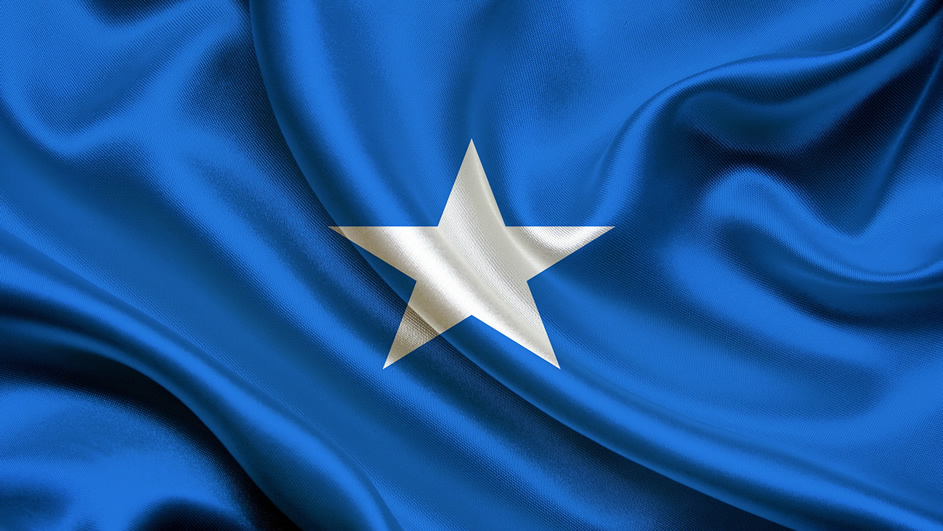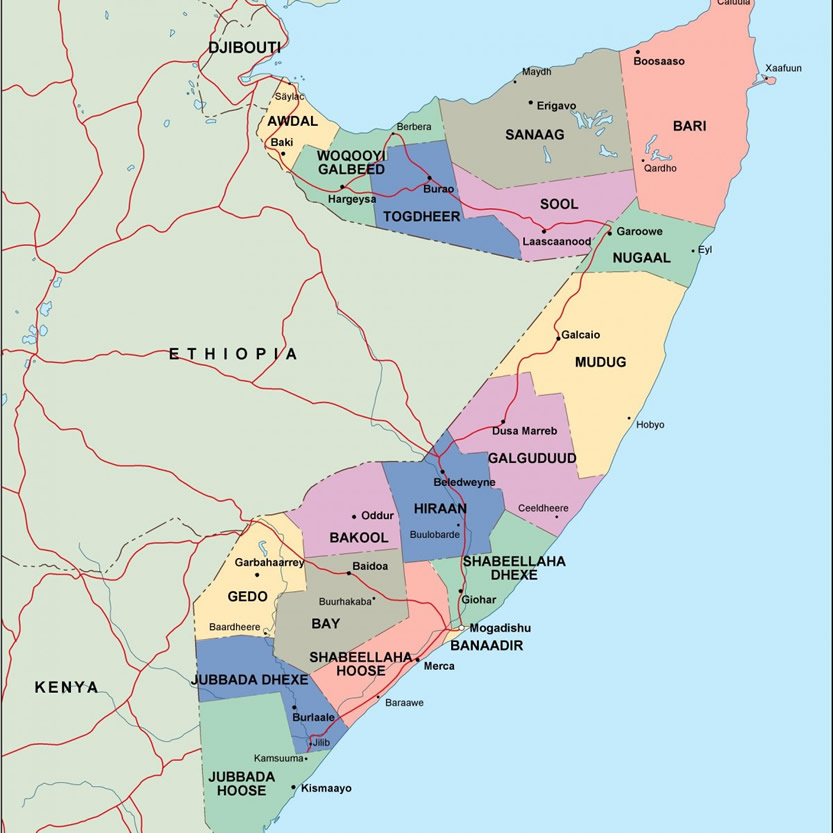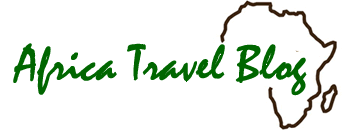Somalia is a former constituent of the British Somaliland Protectorate which attained its independence on the 26th of June 1960. This country was then unified with the Italian Somaliland on the 1st of July 1960.
At present, Somalia is one of the most unstable region on the African Continent. Since the fall of Mohamed Siad Barre who was overthrown in 1991; the country has been ruled by militia factions and warlords. Fighting between various groups and clans breakout frequently and the country’s economy has suffered greatly.
Famine occurs regularly and many Somalis depend on relief aid for survival. There are also a large number of Somali refugees in neighboring countries and a number that have relocated oversees. A peace initiative brokered by the Kenyan Government ended in October 2004 with the formation of a transitional government (Somalia Transitional Federal Institutions) led by Abdullahi Yusuf Ahmed. The authority of this new institution is yet to be fully realized in the country.
Administration:
Mogadishu is the capital city of Somalia. The country is divided into 18 administrative regions known as “gobolka”. These are; Awdal, Bakool, Banaadir, Bari, Bay, Galguduud, Gedo, Hiiraan, Jubbada Dhexe, Jubbada Hoose, Mudug, Nugaal, Sanaag, Shabeellaha Dhexe, Shabeellaha Hoose, Sool, Togdheer, Woqooyi Galbeed.
The Flag of Somalia:

The current flag of Somalia was adopted on the 12th of October 1954 and despite a succession of coups, it hasn’t changed. The colors on the flag were adopted from those of the United Nations flag. Somali attained its independence following intervention by the United Nations.
The blue color on the flag represents the skies and the five point white star represents the five main Somali groups; the Issas, Ethiopian-Somalis, Issaks, Somalis from the Italian-Somaliland and Kenyan-Somalis.
Somalia Map:

Health in Somalia:
The HIV/AIDS prevalence rate in Somalia is not as high as in many African nations. It is estimated that there are about 43,000 people living with the condition in the country.
Health institutions are almost non-existent mainly caused by civil wars which led to an exodus of trained professionals and the destruction of health facilities. Current problems facing the health sector include a lack of skilled staff, facilities and limited support from the government which is yet to fully assert itself in the country. There is a high prevalence of hygiene related illnesses such as diarrhea and typhoid as well as malnutrition. Safe drinking water is hard to come.
Somalia Currency:
The Somali Shilling is the official currency of the country and has been used here since its introduction during British occupation. There are a number of issues affecting the shilling including illegal printing by a number of businesses and the introduction of different currencies in regions that have declared themselves independent. The Republic of Somaliland has introduced its own Somaliland Shilling.
Denominations:
One shilling is equivalent to 100 cents. Coin denominations exist for 5, 10, 25, 50 and 100 shillings. Banknotes exist for 5, 10, 20, 50, 100, 500 and 1000 shillings.
Somalia Facts & Figures:
– Location: Eastern Africa, off the Indian Ocean and the gulf of Aden, east of Ethiopia and Kenya.
– Capital City: Mogadishu.
– Population: 8, 863, 338.
– Other major towns and cities: Kismayu, Berbera, Merca, Baidoa, Galcaio, Hargeysa.
– Religion: mainly Sunni Muslim.
– Languages: Somali (official), Arabic, Italian, English.
– Currency: Somali Shilling (SOS).
Somali Economy:
The development of the Somali economy has been heavily hampered by decades of civil war and instability. The country’s currency has been heavily devalued and Somalia is ranked amongst the poorest and least developed nations of the world.
The situation at present is made worse by ongoing instability and a lack of skilled workers. Agriculture accounts for a large percentage of the country’s economy though unreliable rainfall regularly affects the sector. Agricultural produce in Somalia includes; cattle, sheep, goats, fish, maize, bananas, rice, sugarcane, mangoes, beans, sorghum, coconut. There are also a number of small industries such as sugar refining, wireless communication, textiles and food processing plants.
Currency:
The Somali Shilling is the official currency of the country and has been used here since its introduction during British occupation. There are a number of issues affecting the shilling including illegal printing by a number of businesses and the introduction of different currencies in regions that have declared themselves independent.
Somali People:
The last official census taken in Somalia was done in 1975. At this time the country was home to an estimated 8, 863, 338 people. Though it can be anticipated that Somalia’s population has grown since, there are a large number of refugees living in neighboring countries and some have relocated oversees.
Ethnic Somalis account for about 85 % of the country’s population other groups including Bantu tribes and Arabs. Somali is the official language and others widely spoken are Arabic, Italian and English. Sunni Islam is the main religion though there is a small Christian population.
Education in Somalia:
After major advances were made to reduce illiteracy levels in the country between the 1970s and 1980s; the development of formal education in Somalia has been greatly affected by instability. A number of once thriving institutions are now non-existent and formal education is out of reach for many Somalis.
The Mogadishu University:
The Mogadishu University is a non-profit institution established in 1996. The institution is based in the capital Mogadishu and offers diploma and degree courses in Law, Education, Arts, Human Sciences, Economics, Management, Computing & Information Technology, Political Sciences, Nursing and Journalism. For more information on the university, its services and courses, you can visit its website at: http://www.mogadishuuniversity.com/
Hotels in Somalia:
Though the tourism industry here has been greatly hampered by instability, there are a number of decent hotels in Somalia.
The most prominent at present is the Ambassador Hotel in the city of Hargeisa. Hargeisa is the capital of the Somaliland republic which has declared its self independence. The city is more stable when compared to other regions of the country and is also served by an international airport.
The Ambassador Hotel is situated less than two kilometers from the airport and is the premier establishment in the city. The hotel offers a good range of amenities and services including; rooms with satellite television and telephone, conference rooms, bakery, restaurants, fitness center, mosque and tennis court.

